- Deer Biology
- Deer Diseases and Parasites
- Chronic Wasting Disease: Questions and answers for Virginia deer hunters
- Hemorrhagic Disease: Questions and answers for Virginia deer hunters
- Abdominal Worms: I killed a deer last year that had a small white worm in its abdominal cavity. Is this normal?
- Warts or Cutaneous Fibromas: I killed a deer last year that had several hard black growths in and on its skin. What causes this?
- Nasal Bots: I killed a deer last year that had something that looked like small grubs in its head. Is this normal?
- Piebald or Albino Deer: A friend of mine killed a strange looking deer that had a lot of white on it. What was it?
- Deer Hunting
- Deer Management
- Deer Damage
- Deer Regulations
- Can I build a fence to confine deer in Virginia?
- Can I own deer in Virginia? Can I move deer into or within Virginia?
- What are the deer hunting season dates this year?
- How are antlered bucks defined in Virginia?
- I do not understand the deer tags on my big game license. Can you explain how they work?
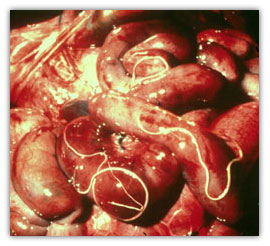
I killed a deer last year that had a small white worm in its abdominal cavity. Is this normal?
Yes. What you found is a very common parasite of deer called the abdominal worm. Its scientific name is Setaria yehi. Adult worms live in the abdominal cavity and produce larvae that circulate in the blood. These larvae are ingested by blood feeding arthropods (e.g., mosquitoes) and develop into the infective stage. They are then transferred to other deer during later blood meals by the vector. Deer less than or equal to one year of age are most often infected, apparently due to the development of immunity in older animals. The worm causes the deer no problems and has no human health implications
I heard about a deer hunter killing an antlered doe. Is that possible?
Yes. There are two types of antlered does. The first are female deer with velvet-covered antlers. These animals usually have normal female reproductive tracts and are capable of bearing fawns. The second type is female deer with polished antlers. These animals are actually male pseudo-hermaphrodites. They have the external genitalia of a female, but have male sex organs internally. Antlered does are extremely rare, with probably only one or two killed annually by deer hunters in Virginia.
Can I build a fence to confine deer in Virginia?
No. A statute passed in 2001 prohibits the construction of a fence with the intent to confine deer. The statute also makes it unlawful to hunt deer in an area where a fence prevents or impedes the free egress of deer (Code of Virginia §29.1-525.1). There are few exceptions to this rule. Zoos, research facilities, fallow deer farms (only 1 in the state), and other permitted facilities may fence deer legally possessed by the operator (i.e., not wild white-tailed deer). Public property can be fenced to protect human health or safety. There are four grandfathered deer enclosures in Virginia in which wild white-tailed deer may be hunted, provided enclosure owners have modified their fences according to a plan approved by the Department.
The Department is routinely contacted by individuals who want to comply with lawful fencing standards regarding deer and deer hunting. Although the Department cannot prevent someone from fencing their private property, the Department does have authority to dictate under what conditions individuals may or may not hunt. 4 VAC 15-90-291 describes the attributes of an enclosed or fenced area deemed to prevent or impede the free egress of deer:
- A fence greater than 61 inches high anywhere along its entire length;
- A fence greater than 61 inches high that incorporates any topographic or other physical barrier that prevents or impedes the free egress of deer;
- A fence or other barrier 61 inches or less in height having any attribute that prevents or impedes the free egress of deer, including but not limited to being slanted, doubled, offset, or electrified; or
- A fence or other barrier, having any of the attributes described in parts 1, 2, or 3 above, that does not have a permanent gap of at least 40 linear feet per every 660 linear feet (1/8 mile) along the fence or barrier, including an additional permanent gap of at least 40 linear feet at every inside angle in the fence or barrier of less than 120 degrees. For the purposes of this regulation, a gap is defined as an interruption in the fence or barrier devoid of any impediment.
Can I own deer in Virginia? Can I move deer into or within Virginia?
No, private individuals are not allowed to own or keep deer in Virginia and deer in this case includes all the members of the deer family (e.g., white-tailed deer, moose, elk, etc.). The only exception to this prohibition are wildlife exhibitors and/or zoos permitted by the Department. These permits are only issued to facilities that serve an educational function and are not issued for pets, hunting enclosures, or other private menageries.
No, you cannot move deer into or within Virginia. As of November 2002, no deer of any species may be moved into or within Virginia without the approval of the Department. The risk of disease transmission — particularly Chronic Wasting Disease (CWD) — has prompted most states to close their borders to imported deer until a suitable quarantine is established and completed. To enforce this moratorium, the Department requires tagging and inventory of all captive deer in the Commonwealth. The Department also requires that all captive deer that die be tested for disease.
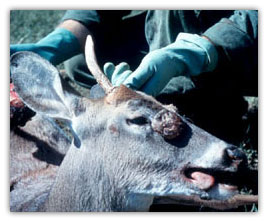
I killed a deer last year that had several hard black growths in and on its skin. What causes this?
You are describing cutaneous fibromas, more commonly called “warts” by deer hunters. They are smooth black to gray hairless tumors of the skin caused by a virus. They can be single, multiple, or in clumps. Although they can be found anywhere on a deer, they are more common on the head, neck, and shoulders. Larger fibromas have a tendency to become infected. The cutaneous fibroma virus of deer is different from those of livestock, and there is no danger of white-tailed deer spreading warts to livestock. When the skin from hunter-killed deer is removed there is typically no evidence of any problem. Only large tumors that become infected with secondary bacterial infection would cause a deer carcass to be unfit for human consumption.
What are the deer hunting season dates this year?
Every year Department staff gets many questions from deer hunters wanting to know the opening dates for next deer season so that they can determine their leave schedule for the upcoming year. It is simpler than it appears. The rules below explain how the different deer season dates are determined.
Archery Deer Seasons
- Early Archery Deer Season (statewide):
- The first Saturday in October through the Friday prior to the third Monday in November.
- Late Archery Deer Season (designated areas (see digest for details)):
- The Sunday following the close of the firearms deer season through the first Saturday in January.
- Late Archery Deer Season
- In Chesapeake, Suffolk (east of the Dismal Swamp line), and Virginia Beach: December 1st through the first Saturday in January.
- Urban Archery Deer Seasons (antlerless deer only and designated areas (see digest for details)):
- Early: the first Saturday in September through the Friday prior to the first Saturday in October.
- Late: the Sunday following the first Saturday in January through the last Sunday in March.
- Northern Virginia Late Archery Deer Season (antlerless deer only)
- In Arlington, Fairfax, Loudoun, and Prince William counties (including the cities and towns within): The Monday following the last Sunday in March through the last Sunday in April.
Muzzleloader Deer Seasons
- Early Muzzleloader Deer Season: (there is no early muzzleloader season in Chesapeake, Suffolk (east of the Dismal Swamp line), and Virginia Beach):
- The Saturday prior to the first Monday in November through the Friday prior to the third Monday in November.
- Late Muzzleloader Deer Season (designated areas (see digest for details)):
- For the 21 consecutive deer hunting days prior to and the first Saturday in January.
Firearms Deer Seasons
- Two Week Firearms Deer Season (designated areas (see digest for details)):
- The Saturday prior to the third Monday in November and for the following 14 consecutive hunting days.
- Four Week Firearms Deer Season (designated areas (see digest for details)):
- The Saturday prior to the third Monday in November and for the following 28 consecutive hunting days.
- Seven Week Firearms Deer Season (designated areas (see digest for details)):
- The Saturday prior to the third Monday in November through the first Saturday in January.
- October/November Firearms Deer Season
- In Chesapeake, Suffolk (east of the Dismal Swamp line), and Virginia Beach: October 1st through November 30th.
- Early Antlerless Only Northern Virginia Firearms Deer Season:
- In Arlington, Fairfax, Loudoun, and Prince William counties (including the cities and towns within) The first Saturday in September through the Friday prior to the first Saturday in October.
- Late Antlerless Only Northern Virginia Firearms Deer Season:
- In Arlington, Fairfax, Loudoun, and Prince William counties (including the cities and towns within) The Sunday following the first Saturday in January through the last Sunday in March.
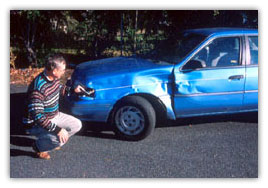
Vehicle damage caused by a collision with a deer.
What can I do to avoid hitting a deer with my car?
Drive defensively, especially in the fall. Fall is the mating season for deer, commonly called the “rut” by deer hunters, and the time of year when deer are the most active. Approximately one-half or more of all deer-vehicle collisions generally occur during the three months of October, November, and December. Below are a series of suggestions that will help minimize your chances of hitting a deer.
- Be especially careful when driving at dawn and at dusk. This time of day is when deer are most active. Unfortunately, after the fall time change, these are also the times of day that most people commute to and from work.
- If you see a deer crossing the road up ahead, slow down immediately and continue to drive slowly until you are past the point where the deer crossed. Female deer frequently travel in groups and more deer may be about to cross.
- Deer habitually use particular areas to cross roads, usually crossing between areas of cover. Drivers should slow down when driving through these areas, particularly at dawn and dusk in the fall. If you see a VDOT deer crossing warning sign, slow down and be more attentive. It is there for a reason.
- Do not swerve to miss a deer. You should brake and stay in your lane. Losing control of your vehicle, crossing into another lane, hitting an oncoming vehicle, or leaving the road and hitting a tree will almost always result in a more serious accident than hitting a deer.
Any person who is involved in a motor vehicle collision that kills a deer or bear is required by law to immediately report the accident to a Conservation Police Officer (Game Warden) or other law enforcement officer in the county or city where the accident occurred. The State does not pay for damages incurred from collisions with wildlife. Consult your insurance company. Drivers who collide with a deer or bear may keep the animal for their own use, provided they report the accident to a law enforcement officer where the accident occurred. The officer will view the animal and give the person a possession certificate.
A friend of mine purchased deer whistles for his SUV. Do they work?
No. There is no data or research to show that deer whistles are effective in reducing deer vehicle collisions.
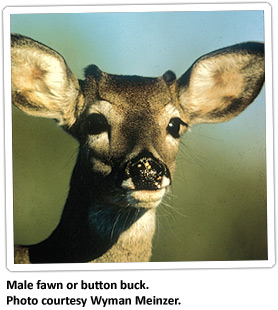
How are antlered bucks defined in Virginia?
By Department regulation, antlered bucks are defined as deer with antlers visible above the hairline. Male white-tailed deer grow their first set of antlers at 1-½ years of age. This means that male fawns (approximately six months old), commonly called button bucks (see photo), are not considered antlered deer. Button bucks are antlerless deer that can be tagged using an antlerless only deer tag. The hair covered bumps or protuberances on a button buck’s head are not antlers. They are the pedicels from which the antlers will grow the next year. Older adult bucks that have shed their antlers, usually in late December or early January, are also considered antlerless deer that can be tagged using an antlerless only deer tag.
I do not understand the deer tags on my big game license. Can you explain how they work?
The Department’s deer tags are pretty simple. There are six deer tags on the big game license, three either-sex and three antlerless only. One of the either-sex tags can only be used east of the Blue Ridge, and it cannot be used on National Forest lands (i.e., on National Forest land in Amherst, Bedford, and Nelson counties). All six deer tags are on one license. Archers and muzzleloaders do not get additional deer tags on their special archery or special muzzleloading license.
Deer hunters commonly call the either-sex deer tags the “buck” tags. They can be used on any deer (antlered or antlerless), but are typically used on antlered deer. They set the annual season bag limit on antlered bucks (3 east and 2 west). A deer hunter cannot get more “buck” tags. Any deer with antlers visible above the hairline must be tagged with an either-sex deer tag. Male fawns, commonly called button bucks, are not considered antlered deer, but are antlerless deer that can be tagged using an antlerless only deer tag. It should also be noted that older adult bucks that have shed their antlers, usually in late December or early January, are also considered antlerless deer that can be tagged using an antlerless only deer tag.
Deer hunters commonly call the antlerless only deer tags “doe tags.” There are three antlerless only deer tags on the big game license for all deer hunters statewide. These tags can only be used on antlerless deer (all does, button bucks, and shed bucks). They cannot be used on antlered deer. However, unlike the season limit of three east and two west either-sex “buck” tags, deer hunters that hunt on private land over the vast majority of the state can get an unlimited number of antlerless only deer tags by purchasing antlerless only bonus deer permits. Antlerless deer may only be taken on designated either-sex deer hunting days. There is no prescribed order for using the deer tags. They can be used in any order.
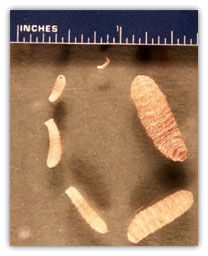
Various stages of development of nasal bots from deer. Photo courtesy of Southeastern Cooperative Wildlife Disease Study.
I killed a deer last year that had something that looked like small grubs in its head. Is this normal?
Yes. What you found are called nasal bots. They are normal parasites of white-tailed deer that are actually larva (i.e., maggots) from flies in the genus Cephenemyia that live in the retropharyngeal pouches of deer (i.e., pouches in the back of the throat). Adult female flies lay a packet of eggs around the mouth or nose of the deer. When the deer licks the eggs the larvae within the eggs are released and migrate to the nasal passages. In the deer, the larvae molt and mature until they are fully developed, at which time they exit the deer and fall to the ground to pupate. When adult flies emerge, the life cycle is completed. Nasal bots do not occur in domestic animals and pose no threat to humans.
A friend of mine killed a strange looking deer that had a lot of white on it. What was it?
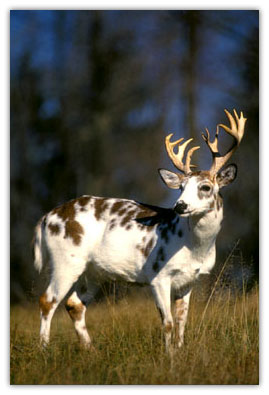
Piebald buck. Photo courtesy of Bill Lea.
It was probably a piebald deer or what deer hunters commonly called calico or pinto deer (see photo). The piebald condition is an inherited genetic trait. The piebald anomaly ranges from a very slight amount of white hair to almost totally white coats. Unlike true albinos, piebald deer have brown eyes and black hooves. The piebald condition is frequently associated with other harmful physical conditions, including skeletal deformities (e.g., dorsal bowing of the nose, short/deformed legs, curved spine, short lower mandible, etc.) and internal organ deformities. Piebald deer are rare, typically occurring at less than one percent of the population. Piebald deer can be more common on a local basis, especially in areas where deer hunters protect them. Piebald deer are not afforded any special protection by Department regulation, and the Department does not recommend these animals be protected.
The other kind of white deer are true albinos. Unlike piebald deer, these deer are normal except for lacking the gene(s) for color. True albinos have pink eyes and white hooves. These deer are rare with just a couple killed annually by deer hunters in Virginia. Like piebald deer, albino deer are not afforded any special protection by Department regulation, and the Department does not recommend these animals be protected.
Should I feed the deer?
Please see the “Should I Feed the Deer?” page for more information.
What is Quality Deer Management (QDM)?
According to the Quality Deer Management Association (QDMA), QDM is the voluntary restraint in harvesting young bucks combined with an adequate harvest of antlerless deer to maintain a population in balance with existing habitat conditions. Quality deer management (QDM) is one of many options for managing deer populations on a farm, hunting club, or other unit of land, including a county. It is the Department’s position that QDM can be practiced voluntarily by landowners/hunt clubs without regulatory statutes mandating this to all hunters. The Department has been involved with QDM since 1988. The vast majority of this effort has been focused on private lands through the Deer Management Assistance Program (DMAP). The WD provides technical guidance to support QDM when practiced by landowners/hunt clubs. Persons wanting more information about QDM are advised to visit the QDMA website.
Is there a statewide Virginia Deer Hunters Association?
Yes, there are several deer hunting organizations that the Department has excellent working relationships with including, but not limited to:
- Shenandoah Chapter of the Quality Deer Management Association (Shenandoah County)
- Suburban Whitetail Management of Northern Virginia (Fairfax County area)
- Traditional Bow Hunters of Virginia (statewide)
- Virginia Bow Hunters Association (statewide)
- Virginia Deer Hunters Association (statewide)
- Virginia Peninsula Sportsmen Association (lower peninsula)
- Western Virginia Deer Hunters Association (Augusta, Rockingham, Shenandoah area)
Is it OK to use deer urine-based scents to attract deer?
No. Effective July 1, 2015, it is illegal to possess or use deer scents/lures that contain natural deer urine or other bodily fluids while taking, attempting to take, attracting, or scouting wildlife in Virginia. A bottle of “deer urine” may contain disease agents harbored by captive deer living hundreds of miles away that were used to collect the infected urine. The most significant threat to Virginia’s deer populations from the use of urine-based scents is the introduction of Chronic Wasting Disease (CWD) into new areas. Synthetic products that can be used to lure deer without the disease risks are readily available at sporting goods stores and from multiple online retailers. Read more…

